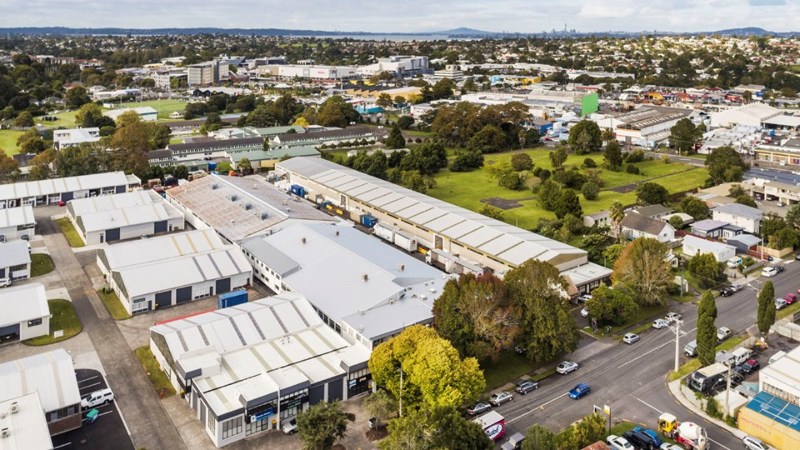JLL’s latest research report – A Sustainable Future – Industrial in New Zealand – says for many businesses, the extent to which they and their corporate real estate partners invest in features which improve environmental, social and governance (ESG) standards is becoming an increasingly important consideration.
Tenants are likely to increasingly demand specific sustainability metrics are met under new lease agreements.
This dynamic is already playing out in the development and acquisition space. Here there is a strong market for larger sites with older improvements which are primed for demolition and redevelopment to modern standards, says JLL’s report.
This is particularly common in the New Zealand market, given that a substantial proportion of industrial stock is of secondary quality and no longer fit-for-purpose in a modern context.
Across an industrial building’s 60-year life cycle carbon contributions stack up.
Emissions before building occupation amount to 28%; emissions released during 60 years of occupation reach 70%; and emissions related to water consumption over the building’s lifecycle amount to 2%.
From an owner-occupier or tenant’s perspective, a focus on improving the sustainability of their premises is important. Not only to their marketability and brand, but also to their capacity to build a financially sustainable business.
A recent report by the New Zealand Green Building Council shows savings on operating costs over a five-year period can be as high as 15% in industrial buildings which are Green Star rated.
World Green Building Council calculations show a 2% upfront cost to support sustainable design principles can result in an average saving of 20% of total construction cost over the lifetime of an asset.
The choice of premises to occupy is already critical in terms of a business’ sustainability credentials, as more than 70% of emissions are released during the occupation phase of a building’s life cycle, says the JLL report.
The way in which these choices are made, including an increased focus on the social and environmental costs of occupying a premises, will have a substantial impact on the types of assets made available in the industrial market.
Growth and expansion
Oxford Economics forecasts indicate New Zealand’s population will grow at an average rate of 0.9% per year from 2021-2025, similar to or higher than most other developed nations.
This will have continuing implications on the industrial market, particularly in underpinning long-term stability in expansionary occupier activity, says JLL’s report
Several major structural changes have been accelerated because of the pandemic. And many of these are going to be long-term boosters of continuing industrial demand, including:
E-commerce adoption
The online retailing sector was relatively immature at the end of 2019, accounting for about 9.8% of total retail sales, according to New Zealand Post’s data.
Covid-19 related restrictions have accelerated the shift towards e-commerce, which reached 10.9% of total sales by December last year. This increased the reliance of retailers on industrial warehousing and logistics providers to reach their customers, says the JLL report.
However, it is unlikely the online retail market will reach the scale of other developed nations, such as the UK which has averaged about 26.3% at the end of last year.
This is primarily due to geographic constraints, specifically the distances between urban centres. They are quite significant and traffic networks busy – particularly around Auckland and Wellington.
The report says there remains scope for further expansion in online retailing bringing the country closer to the global average of 18.9%, which will drive further industrial property expansion.
Because New Zealand has a high rate of urbanisation – 87% – in comparison to most countries, it provides opportunities for retailers and logistics providers to service large population numbers from single locations.
This also encourages the expansion of online retailing platforms, which flows through to industrial demand.
Food retailing
Food retailing is becoming an increasingly significant part of the retail expenditure and industrial property expansion.
Over the 12 years to the end of 2007, food retailing accounted for an average of 34% of retail sales.
It increased to an average of 38% over the following 12 years, reaching a peak of 40% during the Covid lockdowns last year.
As food retailers continue to expand their online platforms, they are also having to expand their supply chain capacity and, with it, their industrial property.
Given the relatively inelastic nature of non-discretionary goods, such as food, it is expected this will continue to be a steady driver of industrial demand over the medium to long-term.
Population a key multiplier
JLL research has calculated Australia has historically produced industrial stock at a rate of approximately 4.5m² per additional resident.
Given the relatively similar market fundamentals and high urbanisation rate, it can be assumed New Zealand requires a similar volume of industrial stock per person.
Based on existing population forecasts from Oxford Economics, it is expected that between 1.0 and 1.3 million square metres of stock will need to be built between 2021 and 2025.
JLL research estimates there are currently 1.15 million square metres of projects in the pipeline across Auckland, Wellington and Christchurch which may be finished during this time.
But, declining land availability and construction cost pressures are making development in these key markets more and more challenging.
Assets failing to adapt will be left behind
Over the long run, assets which fail to keep up with the evolving ESG requirements will likely risk extended vacancies, shorter lease terms and declining asset values.
To hedge against this, investors and owners of stabilised assets will need to become increasingly selective in their capital allocation.
This will include accounting for a broader range of factors in analysing the long-term viability of the income stream of a particular asset.
Developers will also need to become progressively thoughtful and deliberate in their design practices and adoption of ESG principles in order to minimise embedded emissions in their assets during the development phase.
In addition, the use of technology to minimise operational emissions (eg solar power, water recycling) will expand beyond the institutional development space, and likely be increasingly retrofitted on existing assets in order to combat future value risks.





 Search
Search
